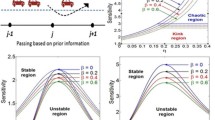Abstract
This paper investigates the effect of aggressive or timid characteristics of driver’s behavior with passing by means of lattice hydrodynamic traffic flow model. The effect of driver’s characteristic on the stability of traffic flow is examined through linear stability analysis. It is shown that for both the cases of passing or without passing the stability region significantly enlarges (reduces) as the proportion of aggressive (timid) drivers increases. To describe the propagation behavior of a density wave near the critical point, nonlinear analysis is conducted and mKdV equation representing kink–antikink soliton is derived. It is observed that jamming transition occurs between uniform flow and kink jam phase with increase in aggressive driver’s characteristics for smaller values of passing. When passing constant is greater than a critical value, jamming transitions occur among uniform traffic flow and kink-Bando traffic wave through chaotic phase. Numerical simulation is carried out to validate the theoretical findings which confirm that traffic jam can be suppressed efficiently by considering the driver’s characteristics in a single-lane traffic system with or without passing.







Similar content being viewed by others
References
Chowdhury, D., Santen, L., Schadschneider, A.: Statistical physics of vehicular traffic and some related systems. Phys. Rep. 329, 199–329 (2000)
Nagel, K., Schreckenberg, M.: A cellular automaton model for freeway traffic. J. Phys. I(2), 2221–2229 (1992)
Helbing, D.: Traffic and related self-driven many-particle systems. Rev. Mod. Phys. 73, 1067 (2001)
Nagatani, T.: The physics of traffic jams. Rep. Prog. Phys. 65, 1331–1386 (2002)
Bando, M., Hasebe, K., Nakayama, A., Shibata, A., Sugiyama, Y.: Dynamical model of traffic congestion and numerical simulation. Phys. Rev. E 51, 1035 (1995)
Jiang, R., Wu, Q.S., Zhu, Z.J.: A new continuum model for traffic flow and numerical tests. Transp. Res. B Methodol. 36, 405–419 (2002)
Gupta, A.K., Katiyar, V.K.: A new anisotropic continuum model for traffic flow. Phys. A 368, 551–559 (2006)
Gupta, A.K., Katiyar, V.K.: Analyses of shock waves and jams in traffic flow. J. Phys. A Math. Gen. 38, 4069–4083 (2005)
Gupta, A.K., Katiyar, V.K.: Phase transition of traffic states with on-ramp. Phys. A 371, 674–682 (2006)
Nagatani, T.: Modified KdV equation for jamming transition in the continuum models of traffic. Phys. A 261, 599–607 (1998)
Nagatani, T.: Chaotic jam and phase transition in traffic flow with passing. Phys. Rev. E 60, 1535 (1999)
Ge, H.X., Cheng, R.J.: The backward looking effect in the lattice hydrodynamic model. Phys. A 387, 6952–6958 (2008)
Peng, G.H., Cai, X.H., Cao, B.F., Liu, C.Q.: Non-lane-based lattice hydrodynamic model of traffic flow considering the lateral effects of the lane width. Phys. Lett. A 375, 2823–2827 (2011)
Peng, G.H.: A new lattice model of traffic flow with the consideration of individual difference of anticipation driving behavior. Commun. Nonlinear Sci. Numer. Simul. 18, 2801–2806 (2013)
Kang, Y.R., Sun, D.H.: Lattice hydrodynamic traffic flow model with explicit drivers physical delay. Nonlinear Dyn. 71, 531–537 (2013)
Ge, H.X., Dai, S.Q., Xue, Y., Dong, L.Y.: Stabilization analysis and modified Korteweg–de Vries equation in a cooperative driving system. Phys. Rev. E 71, 066119 (2005)
Ge, H.X.: The Korteweg–de Vries soliton in the lattice hydrodynamic model. Phys. A 388, 1682–1686 (2009)
Ge, H.X., Cheng, R.J., Lei, L.: The theoretical analysis of the lattice hydrodynamic models for traffic flow theory. Phys. A 389, 2825–2834 (2010)
Nagatani, T.: Jamming transitions and the modified Korteweg–de Vries equation in a two-lane traffic flow. Phys. A 265, 297–310 (1999)
Peng, G.H.: A new lattice model of two-lane traffic flow with the consideration of optimal current difference. Commun. Nonlinear Sci. Numer. Simul. 18, 559–566 (2013)
Peng, G.H.: A new lattice model of the traffic flow with the consideration of the driver anticipation effect in a two-lane system. Nonlinear Dyn. 73, 1035–1043 (2013)
Gupta, A.K., Redhu, P.: Analyses of drivers anticipation effect in sensing relative flux in a new lattice model for two-lane traffic system. Phys. A 390, 5622–5632 (2013)
Gupta, A.K., Redhu, P.: Analyses of the drivers anticipation effect in a new lattice hydrodynamic traffic flow model with passing. Nonlinear Dyn. 76, 1001–1011 (2014)
Zhang, M., Sun, D.H., Tian, C.: An extended two-lane traffic flow lattice model with drivers delay time. Nonlinear Dyn. 77, 839–847 (2014)
Peng, G.H., Cai, X.H., Liu, C.Q., Cao, B.F.: A new lattice model of traffic flow with the consideration of the drivers forecast effects. Phys. Lett. A 375, 2153–2157 (2011)
Peng, G.H., Nie, F.Y., Cao, B.F., Liu, C.Q.: A drivers memory lattice model of traffic flow and its numerical simulation. Nonlinear Dyn. 67, 1811–1815 (2012)
Sharma, S.: Lattice hydrodynamic modeling of two-lane traffic flow with timid and aggressive driving behavior. Phys. A 421, 401–411 (2015)
Sharma, S.: Effect of drivers anticipation in a new two-lane lattice model with the consideration of optimal current difference. Nonlinear Dyn. 81, 991–1003 (2015)
Author information
Authors and Affiliations
Corresponding author
Appendix
Appendix
In this appendix, we give the expansion of each terms in Eq. (8) using Eqs. (17) and (18) to the fifth order of \(\epsilon \).***
The expansion of optimal velocity function at the turning point is
Using Eqs. (36) and (37), we get
Some other important expansions are also computed using Eqs. (32)–(38) and are given as
By inserting (32), (33), (35), (38), and (39) into Eq. (8), we obtain Eq. (19).
Rights and permissions
About this article
Cite this article
Sharma, S. Modeling and analyses of driver’s characteristics in a traffic system with passing. Nonlinear Dyn 86, 2093–2104 (2016). https://doi.org/10.1007/s11071-016-3018-4
Received:
Accepted:
Published:
Issue Date:
DOI: https://doi.org/10.1007/s11071-016-3018-4




